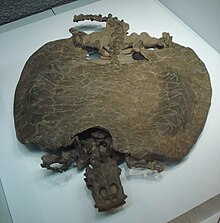Our website is made possible by displaying online advertisements to our visitors.
Please consider supporting us by disabling your ad blocker.
Cyamodontoidea
| Cyamodontoidea Temporal range: Triassic
| |
|---|---|

| |
| Fossil of Henodus chelyops in the Staatliches Museum für Naturkunde Stuttgart | |
| Scientific classification | |
| Domain: | Eukaryota |
| Kingdom: | Animalia |
| Phylum: | Chordata |
| Class: | Reptilia |
| Superorder: | †Sauropterygia |
| Order: | †Placodontia |
| Superfamily: | †Cyamodontoidea Nopsca, 1923 |
| Families | |
Cyamodontoidea is an extinct superfamily of placodont marine reptiles from the Triassic period. It is one of the two main groups of placodonts, the other being Placodontoidea. Cyamodontoids are distinguished from placodontoids by their large shells, formed from fused bony plates called osteoderms and superficially resembling the shells of turtles. Cyamodontoids also have distinctive skulls with narrow, often toothless jaws and wide, flaring temporal regions behind the eyes. Two large temporal openings are positioned at the top of the back of the skull, an arrangement that is known as the euryapsid condition and seen throughout Sauropterygia, the marine reptile group to which placodonts belong. Cyamodontoids are also distinguished by their large crushing teeth, which grow from the palatine bones on the roof of the mouth.[1]
- ^ Rieppel, O. (2002). "The dermal armor of the cyamodontoid placodonts (Reptilia, Sauropterygia): morphology and systematic value". Fieldiana. 46: 1–41.
Previous Page Next Page


